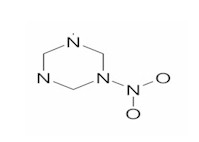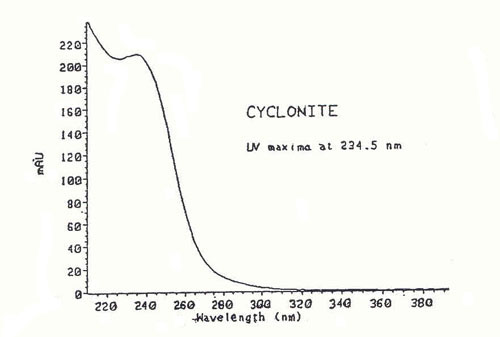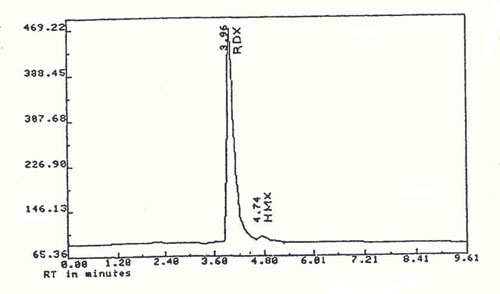1. General Discussion
1.1 Background
1.1.1 History of
procedure
A set of samples collected on glass fiber filters in
tandem with tenax tubes requesting the analysis of RDX was received at
the OSHA Lab.
This evaluation was undertaken to determine the
effectiveness of a glass fiber filter as a sampling device for RDX.
This study indicates a tenax backup tube is not
necessary.
1.2.1 Toxic effects (This section is for
information only and should not be taken as the basis of OSHA
policy).
Cyclonite is a highly explosive solid, more powerful
than TNT, that found extensive use during World War II. RDX is
desensitized by mixing it with TNT to form cyclotols or by coating it
with waxes, synthetic polymers, and elastomeric binders. RDX made in
the U.S. is converted into either Composition B (60% RDX, 40% TNT, pt
wax) or Composition A3 (RDX 91% wax 9%). (Ref. 5.1-5.2)
The
following paragraph describing the toxicity of RDX is excerpted from
the book Documentation of the Threshold Limit Values. (Ref. 5.2)
The clinical manifestations referable to the central
nervous system of nausea, vomiting, convulsions and unconsciousness
seen in the workers paralleled those previously reported in animals
by von Oettingen and Sunderman. Animals studies show RDX not to be
an acutely toxic substance. Human illness results from repeated
exposures via the respiratory and gastrointestinal tracts and by
skin absorption. The following paragraph describing some
effects and symptoms of RDX were taken from Industrial Hygiene And
Toxicology. (Ref. 5.3)
Epileptiform seizures have occurred in workplace
manufacturing trimethylenetrinitramine (T4)[RDX] in
Italy. The convulsions occurred either without warning or
after 1 or 2 days of insomnia, restlessness, and
irritability. They were generalized tonic-clonic convulsions
resembling in all clinical respects the seizures seem in epilepsy
but occurring in individuals without a previous history of seizures.
They were most frequent in persons doing the drying sieving, and
packing where the dust could be inhaled. The attacks disappeared
when the workers were removed from contact with
trimethylenetrinitramine. The seizures were followed by temporary
post convulsive amnesia, malaise, fatigue, and asthenia but there
was eventually complete recovery. When cyclonite dust
control was maintained below 1.5 mg/m3, relative good
health has been reported. This TLV-TVA value was based on a suggestion
by von Oettingen and co-workers. RDX has been given a TLV-TVA of 1.5
mg/m3 by the ACGIH. (Ref. 5.3)
OSHA adopted this
same value as its PEL in March 1989.
Editorial Note: These March
1989 PELs were vacated on July 7, 1992 and ceased to be enforceable on
March 23, 1993 (FR
58:35338-35351, 6/30/1993).
1.1.3 Potential
workplace exposure
Widespread exposure to workers handling
cyclonite occurred during World War II, and as late as 1962.
No
estimate of worker exposure to RDX since 1962 could be found.
Potential exposure involves those individuals in manufacturing,
formulation, and application of RDX.
1.1.4 Physical
properties (Ref. 5.1-5.6)
| Molecular weight: |
222.26 |
| |
|
| Molecular formula: |
C3H6N606 |
| |
|
| CAS #: |
121-82-4 |
| |
|
| IMIS #: |
2224 |
| |
|
| Melting point: |
205 to 206°C |
| |
|
| Vapor
Pressure: |
Log10pa = 16.26
- 6785/K or
Log pmHg = 14.14 - 6785/K |
| |
|
| Appearance: |
white crystalline
solid |
| |
|
| Solubility: |
One gram in 25 ml acetone;
slightly soluble in acetonitrile, methanol, ether, ethyl
acetate, glacial acetic acid; practically insoluble in water:
carbon tetrachloride, carbon disul-
fide |
| |
|
| Synonyms: |
RDX, Cyclonite, T4 Hexogen
Tri-
methylenetrinitramine,
Cyclotrimeth-
ylenetrinitramine,
l,3,5-trinitro-
hexahydro-s-triazine |
| |
|
| Chemical names: |
Hexahydro-1,3,5-trinitro-1,3,5-triazine |
| |
|
| UV spectrum: |
See Figure 1. |
| |
|
| Stability: |
Stable (stored for 10
months at 85°C
without perceptible deterioration), Class A
explosive (detonation occurs by: sudden shock, high temperature,
or combination of the two) |
| |
|
| Structural formula: |
 |
1.2 Limit defining parameters
The detection
limit of the analytical procedure is 4.823 ng per injection. This is the
amount of analyte which will give a peak whose height is approximately
five times the baseline noise. 2.
Sampling Procedure
2.1 Apparatus
2.1.1 A personal sampling pump
that can be calibrated to within ±5% of the recommended flow rate with
the sampling device in line.
2.1.2 A 37-mm glass fiber
filter mounted in a polystyrene cassette (with backup
pad). 2.2
Reagents
No sampling reagents are required.
2.3
Sampling technique
2.3.1 Immediately before sampling, remove the
plastic plugs
from the filter cassette.
2.3.2 Attach
the cassette to the sampling pump with flexible tubing and place the
cassette in the worker's breathing zone in such a manner that it does
not impede work performance.
2.3.3 After sampling for the
appropriate time, remove and seal cassette with plastic end
caps.
2.3.4 Wrap each sample end-to-end with an OSHA seal
(Form 21).
2.3.5 Submit at least one blank with each set
of samples. Handle the blank the same as the other samples but do not
draw air through it.
2.3.6 Submit any bulk samples in a
separate container. Do not ship them with the air
samples. 2.4 Extraction
efficiencies
Nine glass fiber filters were each liquid spiked
with a solution of RDX at a concentration of 4.859 mg/mL. Three filters
were each liquid spiked with 18 µL (.5x PEL) of RDX standard. A second
group of three filters were each liquid spiked with 38 µL (lx PEL) of
RDX standard. A third group of three filters were each liquid spiked
with 76 µL (2x PEL) of RDX standard. These filters were allowed to sit
overnight on a desk at ambient temperature and then extracted with 3.0
mL of acetonitrile and analyzed as in Sections 3.4 and 3.5.
Table
2.4
Glass Fiber Filter Extraction Study
|
| Filters |
.5x |
1x |
2x |
|
F1
F2
F3 |
100.3%
100.4%
90.0% |
106.8%
97.3%
104.5% |
95.3%
101.1%
91.2% |
|
| Averages |
96.9% |
102.9% |
95.9% |
2.5 Retention efficiency
Five glass fiber
filters were each liquid spiked with 76 µL (2x PEL) of a 4.859 mg/mL
solution of RDX standard. One hundred twenty liters of humid air
(approximately 70% relative humidity) were drawn through each of four
filters. The fifth filter had 285 liters of humid air drawn through it
and had a recovery of 101.9% All five of these filters were then
extracted and analyzed as in Sections 3.4 and 3.5.
Table
2.5
Retention Efficiency Study
|
| Filters # |
Recovery |
|
RET1
RET2
RET3
RET4 |
107.0%
99.5%
98.3%
89.7% |
|
| Average
recovery is 98.6% |
2.6 Sample storage
Eighteen glass fiber
filters were each liquid spiked with 38 µL (lx PEL) of a 4.859 mg/mL
solution of RDX. One hundred twenty liters of humid air (approximately
70% relative humidity) were drawn though each filter. Half of the
filters were stored in a drawer at ambient temperature, and the other
half were stored in a refrigerator (2°C). They were stored according to
Table 2.6 and extracted and analyzed as in Sections 3.4 and
3.5.
Table
2.6
Storage Study
|
| Days |
Ambient |
Averages |
Refrigerator |
Averages |
|
| 0 |
99.9% |
|
103.2% |
|
| |
99.7% |
|
108.9% |
|
| |
102.9% |
100.8% |
108.4% |
106.8% |
| 7 |
97.6% |
|
100.8% |
|
| |
103.3 |
|
94.9% |
|
| |
96.1% |
99.0% |
97.7% |
97.8% |
| 15 |
97.7% |
|
95.5% |
|
| |
95.7% |
|
98.4% |
|
| |
91.4% |
94.9% |
98.3% |
97.4% |
|
| Average
recovery (ambient) 98.2% |
| Average
recovery (refrigerator)100.7% |
2.7 Recommended air volume and sampling rate.
2.7.1 The recommended air volume
is 120 L.
2.7.2 The recommended flow rate is 1.0
L/min. 2.8 Interferences
(sampling)
It is not known if any compounds will interfere with
the collection of RDX. Suspected interferences should be reported to the
laboratory with submitted samples. HMX (also an explosive) is a
contaminant of and associated with RDX manufacturing and
collection.
2.9 Safe precautions (sampling)
2.9.1 Attach the sampling
equipment in such a manner that it will not interfere with work
performance or employee safety.
2.9.2 Follow all safety
practices that apply to the work area
being
sampled. 3.
Analytical Procedure
3.1 Apparatus
3.1.1 An HPLC equipped with a UV
detector and a manual or automatic injector. A Waters 600 pump, Waters
712 autosampIer and Waters 490E UV detector were used in this
evaluation.
3.1.2 An HPLC column capable of separating
RDX from any interferences. A (25 cm x 4.6 mm i.d.) Econosphere CN
(5-micron) column was used in this evaluation.
3.1.3 An
electronic integrator or other suitable means of measuring detector
response. A Hewlett-Packard 3357 data system was used in this
evaluation.
3.1.4 Vials, 4-mL glass including septa lined
with polytetrafluoroethylene (PTFE).
3.1.5 Volumetric
flasks, pipets, and syringes. 3.2 Reagents
3.2.1 Acetonitrile,
Tetrahydrofuran, HPLC grade.
3.2.2 Water, BPLC grade. A
Millipore Milli-Q system was used to prepare the water in this
evaluation.
3.2.3 RDX. A 91% pure standard with 9%
MIL-C4408 desensitizer was used in this
evaluation. 3.3 Standard
preparation
Prepare stock standard solutions by adding
tetrahydrofuran to preweighed amounts of RDX. Prepare working range
standards by diluting stock solutions with acetonitrile. Store stock and
dilute standards in a freezer.
3.4 Sample
preparation
3.4.1 Transfer glass fiber
filter from the cassette to a 4-mL vial.
3.4.2 Add 3.0 mL
of acetonitrile to each vial.
3.4.3 Seal the vials with
PTFE-lined septa and shake them for half an hour on a mechanical
shaker. 3.5
Analysis
3.5.1 Liquid chromatographic
conditions
Column:
|
25 cm x 4.6 mm i.d. stainless
steel
column packed with 5 micron Econosphere CN |
| |
|
| Mobile Phase: |
42% acetonitrile / 58% water |
| |
|
| Flow rate: |
1 mL/min |
| |
|
| UV detector: |
230 nm |
| |
|
| Retention time: |
3.96 min |
| |
|
| Injection volume: |
10
µL |
3.5.2
Chromatogram (See Figure 2) 3.6 Interferences (analytical)
3.6.1 Any compound having a
retention time similar to that of the analyte is a potential
interference. Generally, chromatographic conditions can be altered to
separate interferences from the analyte. HMX is a possible
interference with RDX and must be separated from
it.
3.6.2 Retention time on a single column is not proof
of chemical identity. Analysis by an alternate HPLC column, detection
at another wavelength (for comparison of absorbance response ratios)
and confirmation by mass spectrometry are additional means of
identification. 3.7
Calculations
3.7.1 Construct a calibration
curve by plotting detector response versus standard
concentration.
3.7.2 Determine the concentration of RDX
in each sample from the calibration curve. If RDX is found, make blank
corrections.
3.7.3 Determine the air concentration by the
following formula.
| |
(µg/mL in sample) x (desorption volume,
mL) |
| mg/m3 = |
|
| |
(air volume, L) x (desorption efficiency,
decimal) |
3.8 Safety precautions (analytical)
3.8.1 Avoid exposure to all
standards.
3.8.2 Avoid exposure to all
solvents.
3.8.3 Wear safety glasses at all times.
4. Recommendations for
Further Study
4.1 A better desorption solvent than acetonitrile
might be found.
4.2 This method should be fully validated
for the following group of polynitro explosives: HMX, RDX, TETRYL, TNT,
2,4-DNT, and 2,6-DNT. It has been shown that all of the above analytes
can be separated from each other by HPLC.

Figure 1. UV Spectrum of RDX in
Acetronitrile |

Figure
2. Chromatogram of RDX |
5. References
5.1 "Kirk-Othmer Encyclopedia of
Chemical Technology", 3rd ed.; Grayson, K.; John Viley and Sons: New
York, NY, 1980; vol. 9, pp 581-584.
5.2 "Documentation of
the Threshold Limit Values and Biological Exposure Indices," 5th ed.;
American Conference of Governmental Industrial Hygienists: Cincinnati,
OH, 1986; P 221.
5.3 "Documentation of the Threshold Limit
Values", 3rd ed.; American Conference of Governmental Industrial
Hygienists: Cincinnati, OH, 19&1 P 221.
5.4 Patty,
P.A.; "Industrial Hygiene and Toxicology", 2nd ed.; John Vileyand Sons:
New York, NY, 1963; vol. 2, pp 2097-2098.
5.6 "Merck
Index", 10th ed.; Vindholz, M., Ed.; Merck and Co.: Rahway, NJ, 1983; P
393.
|

